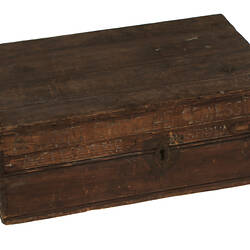Summary
Digital image copied from black and white photograph showing Giuseppe (John) Minniti some days after arriving on the 'Sebastiano Caboto' at Victoria Dock, Melbourne, 28 April 1950. He has been greeted by the Butler, Gagliardi and Muratore families. This image relates to the small wooden hand made travelling case, made and used by Giuseppe Giovanni Minniti when he migrated to Melbourne from his home in Limpidi, Calabria in Italy in 1950.
Giuseppe wished to avoid national service in Yugoslavia and departed from Messina, Italy on the ship 'Sebastiano Caboto' on 23 March, travelling alone via the Suez Canal. He arrived at Victoria Dock Melbourne on 22 April 1950. Giuseppe made the small suitcase in a hurry in order to carry items at the request of friends and relatives to take with him to people in Melbourne. He had another trunk to transport his own personal belongings. Soon after his arrival he moved to South Gippsland where he worked as a farm hand. Almost three months later, Giuseppe moved back to Melbourne and after a short stint at the Windsor Smith shoe factory in Fitzroy, he joined the Victorian Railways at Footscray Station for eight years. Giuseppe purchased a house in Footscray and rented out rooms to two other men. At this time he also had an informal barber's outlet from home where he cut hair for family, friends and neighbours. He married Giulia in 1959, moved to another house in Footscray and the couple had four children. From 1967 the couple ran a milk bar for seven years and then Giuseppe worked for Repco for the rest of his working life.
Description of Content
A group of people standing on a ship's deck.
Physical Description
Black and white digital image.
Significance
This photo relates to Giuseppe Minniti's travelling case which is an iconic symbol of the migrant experience, reflecting the journey, and the modesty of the number of possessions brought. The inscriptions offer a very personalised and visual record the individual's departure point and destination. The case was originally purchased in an opportunity shop and its historical value was substantially increased in 2012 when the family recognised their father's case on the Museum's website and contacted the Museum in order to share their family story and photographs.
More Information
-
Collecting Areas
-
Acquisition Information
Loan for Copying from Minniti Family, 27 Jun 2012
-
Place & Date Depicted
Victoria Dock, Port Melbourne, Greater Melbourne, Victoria, Australia, 28 Apr 1950
-
Person Depicted
Giuseppe Minniti, Victoria Dock, Port Melbourne, Greater Melbourne, Victoria, Australia, 28 Apr 1950
-
Individuals Identified
Frank Gagliardi; Cousin Goe Minniti; Collins Butler; Domenic Muratore; Mrs Butler; Mrs Boffa; Prof Goe Muratore; Dominic Gagliardi
-
Format
Digital file, Black & White
-
Inscriptions
Inscribed on reverse: 'On the Ship, SEBASTINO CABOTO / TOP. FRANK GAGLIADI & COUSIN GOE MINNITI / FROM ITALY / ARRIVED ON THIS SHIP 23-4-1950 / BOTTOM ROW. COLLINS BUTLER - DOMENIC MURATORE (GOING TO ITALY) / MRS. BUTLER - MRS. BOFFA - PROF. GOE MURATORE and DOMENIC GAGLIARDI - / VIC. DOC MELB. 28-4-1950'.
-
Classification
-
Category
-
Discipline
-
Type of item
-
Keywords
Migration & Settlement, Shipboard Travel, Italian Immigration

